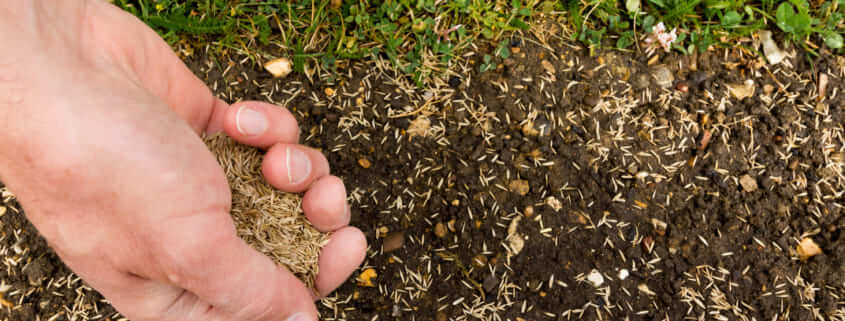As the leaves and temperatures start to drop, you might want to take steps to improve the health of your lawn. Fall is a great time to plant, especially for certain varieties of grasses. For those who are looking for a lush and healthy lawn, there are a few tips that you will want to follow. With this handy guide, you can ensure that you have the best-looking lawn in the neighborhood.
When To Plant Your Grass
Like many homeowners, you want to know when to plant your grass. However, the answer is not always straightforward. Depending on the type of grass, fall or spring plantings work the best. If you have a cool-season grass, then fall is the best time to seed. These grasses love the milder temperatures, and they can thrive with the shorter days and cooler nights.
For those warm-season grasses, you will want to plant in the late spring or early summer. It is important to seed after the last frost in your area. These grasses will all thrive when you stick to this schedule.
You Need To Plan for the Future
Now that you know cool-season grasses do exceptionally well with a fall planting, you should think about seeding your lawn around Labor Day. With this schedule, you can give the new seedlings time to establish before the cold winter days. In addition to that, you can avoid those scorching hot summer temperatures.
You should always keep a watchful eye on the weather forecast. If you live in an area that experiences a late heatwave or early cold snap, it can affect the seeds’ germination process. It is important to get your grass seeds off to a good start. For those areas expecting heavy rains in the forecast, hold off on the planting. All your hard work could get washed away with a downpour.
If you usually add a weed control product to your yard, you need to take extra precautions. Before you use this product, consult the label for additional instructions. Some of these chemicals are harmful to those newly planted grass seeds.
Prepare Your Space
If you are ready to plant your grass seed, these tips can help you prepare your soil. For the first step, you want to remove all debris, stones, or wood from your planting area. You want a clean soil base for your seeds. Once that is done, you should take a spade and create a row in the soil. For those areas with hard dirt or clay, you can till the ground to break up those compacted clumps.
At this stage, add a layer of seeding soil and smooth it out with a landscape rake. Areas with recessed areas can be leveled out to give your planting space a smooth surface. Grass seeds need about 3 inches of rich soil for the best results. You can also use seeding soil with a fertilizer to help accelerate the growing process.
Plant Your Seeds
If you want to have a healthy lawn, you must add high-quality seeds to your turf. With better quality seeds, you can ensure strong growth for your lawn. Before you add the seeds, make sure to measure the planting area. The grass seeds’ packaging will recommend the right amount of seeds to use per square foot. For the most part, you want to use about 4 to 8 pounds of seed per 1,000 square feet of yard.
You may be tempted to add more seeds for a thicker lawn, but it can lead to overcrowding. As a result of that, overcrowding can choke the growth of the grass. A drop spreader is the best tool to ensure uniform coverage. If you have a small area, then a hand spreader can do a great job.
You Can Expedite Germination
For those who want to encourage sprouting and protect the seeds, there are a few things that you can do for a successful growing season. Losing the seeds is a big problem for many homeowners. Birds can eat the seeds, or the seeds can blow away. You can use a lawn roller to tamp down those seeds. These tools can be rented from a home improvement store.
If you want to further protect your seeds from washing away in the rain, then you might want to add a thin layer of mulch. However, you don’t want to add too many layers to your lawn. With a heavy layer of mulch, your seeds will not be able to push through the surface.
Finally, the proper watering schedule is a vital component of the growing process. You want the soil to remain moist throughout the germination stage. Water should penetrate the ground down to 6 inches. Early morning and night are the ideal times to water your seeds. For those dry areas, you might want to water about three to four times a day. A hand sprinkler is gentle enough to avoid washing away your seeds.
What To Expect for Your Grass Seeds
Those cool-weather grasses will begin to sprout in two weeks. If you do not see any seeds after two weeks, you might need to reseed your space. Once the seeds are visible, you still need to continue with your watering schedule. Daily watering should proceed until the grass measures up to an inch.
When the grass is ready to be cut by a lawnmower, you can reduce the watering schedule to once or twice a week. However, you still want to add enough water to reach and hydrate the roots. Once the roots have been established, you can be assured that your grass will survive the harsh winter season.
We’re the Grass Experts
At Charlestown Landscaping, we will help answer all your grass-related questions. Our team can also handle all those other lawn care needs for your grass. In addition to that, we offer landscaping and snow removal services. If you would like to discuss your maintenance needs with us, please fill out the contact form.

